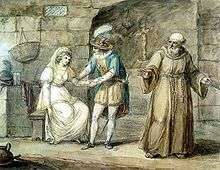Friar Laurence
| Friar Laurence | |
|---|---|
 Romeo and Juliet with Friar Laurence by Henry William Bunbury | |
| Creator | William Shakespeare |
| Play | Romeo and Juliet |
Friar Laurence[n 1] is a fictional character in William Shakespeare's play Romeo and Juliet.
Role in the play
Friar Laurence is a friar who plays the part of a wise adviser to Romeo and Juliet, along with aiding in major plot developments.
Alone, he foreshadows the later, tragic events of the play with his soliloquy about plants and their similarities to humans.[1] When Romeo requests the Friar marry him to Juliet, he is shocked, because only days before, Romeo had been infatuated with Rosaline,[2] a woman who did not return his love. Nevertheless, Friar Laurence decides to marry Romeo and Juliet in the attempt to stop the civil feud between the Capulets and the Montagues.[3]
When Romeo is banished for killing Tybalt and flees to Mantua, Friar Laurence tries to help the two lovers get back together using a potion to fake Juliet's death.[4] The friar sends a letter to Romeo explaining the situation, but it does not reach him because the people of Mantua suspect the messenger came from a house infected with the plague,[5] and the Friar is unable to arrive at the Capulet's monument in time. Romeo kills Count Paris,[6] whom he finds weeping near Juliet's corpse, then commits suicide,[7] by drinking poison that he bought from an impoverished apothecary,[8] over what he thinks is Juliet's dead body. Friar Laurence arrives just as Juliet awakes from her chemically induced slumber.[9] He urges Juliet not to be rash, and to join a society of nuns,[10] but he hears a noise from outside and then flees from the tomb. Juliet then kills herself with Romeo's dagger, completing the tragedy. The Friar is forced to return to the tomb, where he recounts the entire story to Prince Escalus, and all the Montagues and Capulets. As he finishes, the prince proclaims, "We have still known thee for a holy man."
Analysis
In the later part of the 18th and through the 19th century, criticism centred on debates over the moral message of the play. Actor and playwright David Garrick's 1748 adaptation excluded Rosaline: Romeo abandoning her for Juliet was seen as fickle and reckless. Critics such as Charles Dibdin argued that Rosaline had been purposely included in the play to show how reckless the hero was, and that this was the reason for his tragic end. In the 20th century, these moral arguments were disputed by critics like Richard Green Moulton. He argued that accident, and not some character flaw, led to the lovers' deaths.[11]
Shakespeare uses a variety of poetic forms throughout the play. He begins with a 14-line prologue in the form of a Shakespearean sonnet, spoken by a Chorus. Most of Romeo and Juliet is, however, written in blank verse, and much of it in strict iambic pentameter, with less rhythmic variation than in most of Shakespeare's later plays.[12] In choosing forms, Shakespeare matches the poetry to the character who uses it. Friar Laurence, for example, uses sermon and sententiae forms, and the Nurse uses a unique blank verse form that closely matches colloquial speech.[13]
Notes and references
- Notes
- ↑ Laurence is the name of the character created by Shakespeare
- References
- ↑ Shakespeare: Romeo and Juliet; 2.3.1-22
- ↑ Shakespeare: Romeo and Juliet; 2.3.180-81
- ↑ Shakespeare: Romeo and Juliet; 2.3.26-31, 2.3.98-99
- ↑ Shakespeare: Romeo and Juliet; 4.1.69-77, 4.1.91-122
- ↑ Shakespeare: Romeo and Juliet; 5.2.5-12
- ↑ Shakespeare: Romeo and Juliet; 5.2.72-73
- ↑ Shakespeare: Romeo and Juliet; 5.2.119-120
- ↑ Shakespeare: Romeo and Juliet; 4.5.66-79
- ↑ Shakespeare: Romeo and Juliet; 5.2.148-50
- ↑ Shakespeare: Romeo and Juliet; 5.3.156-164
- ↑ Scott (1987: 411–412).
- ↑ Halio (1998: 51).
- ↑ Halio (1998: 51).
Bibliography
- Halio, Jay (1998). Romeo and Juliet: A Guide to the Play. Westport: Greenwood Press. ISBN 0-313-30089-5.
- Mark W., Scott (1987). Shakespearean criticism: excerpts from the criticism of William Shakespeare's plays and poetry, from the first published appraisals to current evaluations. 5. Detroit: Gale Research Inc. ISBN 0-8103-6129-9.